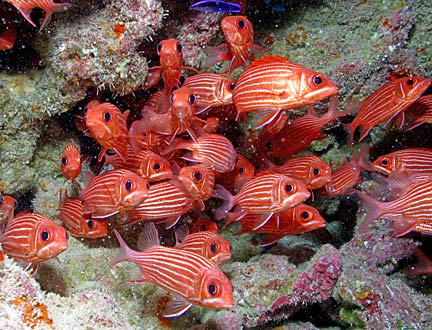
|
Northwestern Islands
get protection plan
State waters surrounding the Northwestern Hawaiian Islands would become a highly protected "marine refuge" under a proposal announced yesterday.
Peter Young, director of the state Department of Land and Natural Resources, visited the remote islands last year and was astonished to see a school of large ulua visible from shore, thousands of birds on a plane runway, and monk seals and sea turtles lounging on beaches.
"We are dealing with a special place, and it's different," Young said yesterday in announcing that he wants to give the Northwestern Hawaiian Islands the highest level of protection.
That would mean no commercial or recreational fishing or removal of any natural or cultural resources from state-controlled waters, according to draft rules to be considered by the Board of Land and Natural Resources at its meeting next Friday. Visits to the refuge would only be allowed for research, management and native Hawaiian cultural purposes that do not harm the environment -- and only then with a state permit.
Western Pacific Regional Fisheries Management Council scientist Paul Dalzell said yesterday that the state's proposal "does set a precedent in terms of state's perspective on what it sees as the future of the Northwestern Hawaiian Islands -- that they see state waters primarily as a conservation area, rather than as an area for fishing or other extractive resource uses."
"I imagine that fishermen may have their own perspective on that," Dalzell said.
State waters extend out from the shores of islands and atolls for three miles and encompass the majority of the coral reefs in the Northwestern Hawaiian Islands.
The Northwestern Islands are a chain of small islands, atolls, submerged banks and reefs that stretch 1,200 miles northwest of the main Hawaiian Islands. The Northwestern Islands have 69 percent of the coral reefs under U.S. jurisdiction, while the main Hawaiian Islands have 15 percent.
Allen Tom, Pacific Islands regional coordinator for the National Marine Sanctuary Program, described the state's proposal as being proactive and forward-thinking. "On behalf of NOAA (the National Oceanic and Atmospheric Administration), we congratulate them," he said.
There is very little fishing in state waters now by the handful of fishermen who bottom-fish in deeper waters off the Northwestern Hawaiian Islands, said Athline Clark, an analyst for the Division of Aquatic Resources. But prohibiting fishing and other "extractive" uses protects the area in the future, as technology changes, she said.
Cha Smith, executive director of the Kahea Hawaiian-Environmental Alliance, praised the state's move as "an extremely visionary and really solidly pono thing to do, because this resource is such a fragile and unique place. ... We are thrilled."
"The state has done the right thing by this resource, and the sanctuary program needs to take notice," said Smith, who has sought protection for the remote islands for years.
Federal waters around the islands out to 50 miles are now part of the Northwestern Hawaiian Islands Coral Reef Ecosystem Reserve and are in the years-long process of becoming the country's 14th National Marine Sanctuary.
Under that process the Western Pacific Regional Fisheries Management Council, which guides fishing policy in federal waters, has objected to suggestions that fishing in the Northwestern Islands be capped at current levels or phased out entirely.
Stephanie Fried, senior scientist with Environmental Defense, called the state's stance "extraordinary."
"This shows how Gov. (Linda) Lingle and Peter Young listened to the people of Hawaii and listened to the public mandate," Fried said. "It's a tremendous step forward."
[News] [Business] [Features] [Sports] [Editorial] [Do It Electric!]
[Classified Ads] [Search] [Subscribe] [Info] [Letter to Editor]
[Feedback]
